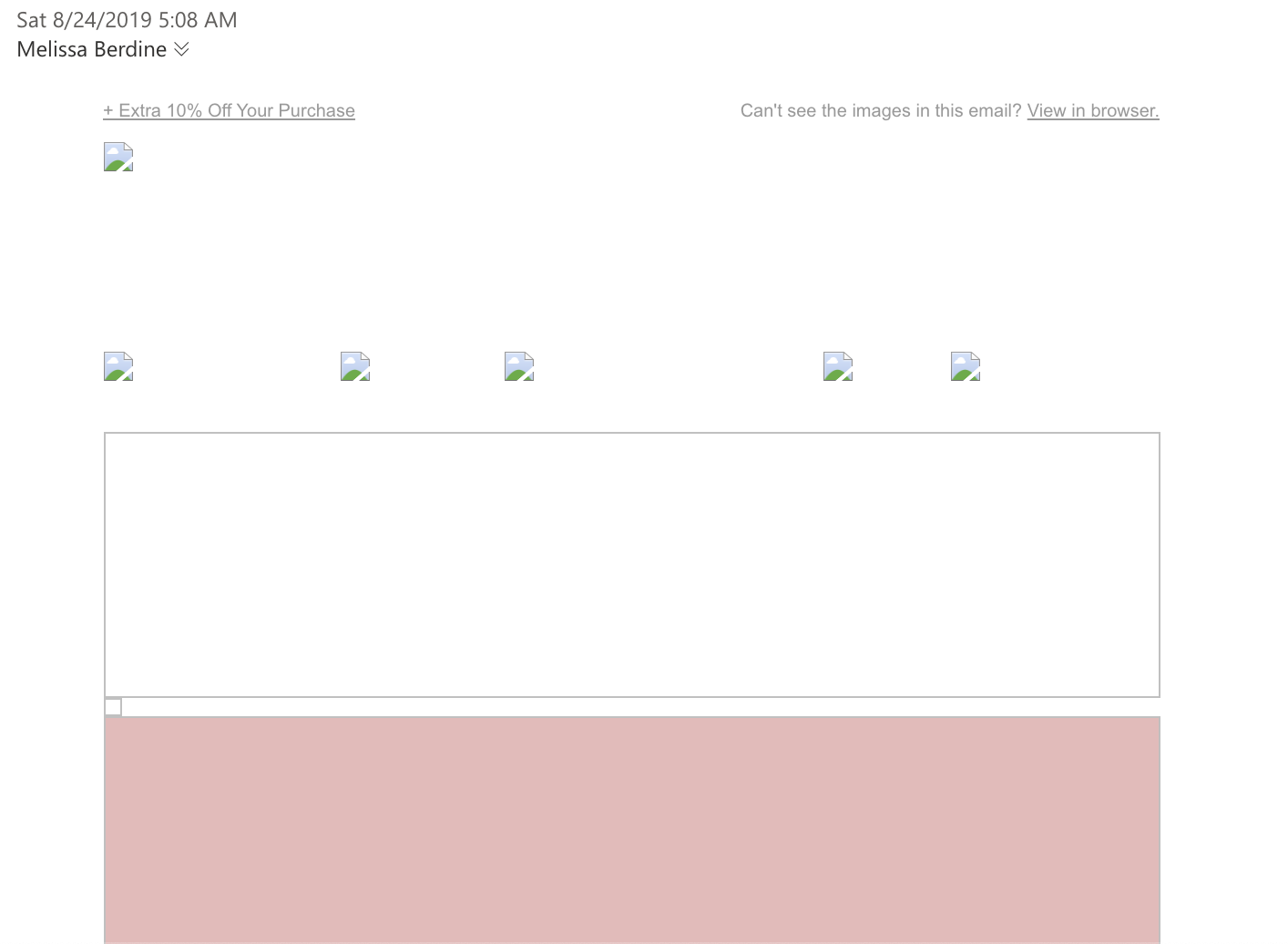Email Development
Splicing Image-Only Emails? There’s a Better Way

Email Development

A picture is worth a thousand words, and an animated GIF is probably worth even more. In trying to win the bid for your subscriber’s attention, email marketers increasingly turn to image or GIF-heavy email campaigns.
We can understand the appeal. These emails may look flawless. Their designs are pristine, and it’s hard to beat the level of branding that they afford.
However, image-only emails, and the process known as email splicing, come with many problems. This article will go over what email splicing is, five reasons why email splicing is best avoided, and five tips for turning image-only emails into something better.
Image splicing refers to creating emails by cutting up a large graphic into pieces and putting them together like a puzzle in the design. So, if they look so great and bring the visual branding bacon home, what’s the drawback?
Well, if you’re looking at it in Outlook, a beautiful email such as this shows up blank – except for a small broken image icon since all images (and therefore content and messaging) are blocked by default.

Unfortunate, right? But email client support problems are just the tip of the iceberg when it comes to image-only email problems.
Image-only emails may look beautiful, but check out these five reasons why they are generally a bad idea:
Let’s dive into each of these issues below.
A picture may be worth a thousand words, but some of your subscribers or their email clients may implement image blocking. This means that they will not be able to see any of your well-crafted email images.
As we mentioned above, most versions of Microsoft Outlook block images by default. As a very widely used email client, this is something you must take into consideration. Unfortunately, no line of email code can override this. The only solution is to work around Outlook’s image blocking.
Here’s a table of email clients that don’t download images by default:
| Email client | Type of service |
| AOL Mail | Webmail |
| Outlook 2007-2019 | Desktop |
| Outlook (Mac) | Desktop |
| Office 365 | Desktop |
| Office 365 (Mac) | Desktop |
Besides these default email client settings, some email clients give their users the option to disable images. If your spliced email’s images don’t populate, a reader won’t be able to connect with or act on your message.
Image-only emails may not be responsive. That is, they might not be properly formatted for mobile devices and can cause display issues. In the case of spliced images, they may end up stacking on mobile devices. So the “puzzle pieces” of a spliced, image-only email would be all jumbled up.
In 2019, 60% of all email opens came from mobile devices. If your email layout is a mess on mobile devices, you risk losing engagement because your campaign becomes unreadable.
Beyond mobile UX issues, splicing emails remove the vast majority of the meaning from your message for people who use screen readers like JAWS or digital assistants like Alexa and Siri to read email. In other words, it makes them virtually inaccessible.
Screen reading software can only do so much to communicate an image to listeners. They’re limited to reading an image’s alt text, assuming it has any. That means any copy that doesn’t have live text won’t be accessible to the subscriber. That includes calls-to-action (CTAs). If a CTA is on an image that the client is blocking, that CTA won’t earn clicks.

Avoid putting your brand in a position where your email ROI relies on a piece of tech and a few lines of alt text to resonate with a reader and make your emails accessible with a mixture of content.
Splicing image-only emails come with a host of potential deliverability problems. Like digital assistants, spam filters can’t detect the contents of an image. So, it’s a way spammers and scammers can hide deceptive content from mailbox providers.
All the receiving mail server knows is that the email is made up of image files. So, regardless of how safe the content is, this is a red flag and can land your email in more spam folders than inboxes.
While email clients don’t publicize their spam filters’ parameters that determine which emails are spam, we do know one such parameter looks at an email’s image-to-text balance. When a spam filter can read a block of text, it has some context to decide if the email is safe to deliver. If it has no way to even guess what the content is, it can enact its why-risk-it setting and divert to spam.
So, just to recap. You’ve got to resist the temptation to design image-only emails and splice them up. It may look good to you, but it could be a horrible experience on mobile devices, image-only emails may trigger spam filters, and they give people using screen readers practically nothing to engage with.
So, let’s say you’ve got some image-only campaigns or spliced email graphics in your current program. What can you do to make them better? Here are some solid suggestions:
Let’s dig into each of these below.
What’s an email marketer to do when images don’t populate? Add some content balance to image-only emails. The age-old question is whether you should be concerned with text-to-image ratio in emails. We recommend keeping a 40-to-60 ratio for images to text, as it improves your email’s readability and helps you avoid unnecessary deliverability issues.
Always use live text for your most important messaging. That way, key pieces of copywriting won’t be hidden if images are blocked, and screen readers will be able to process the content.
Alternative (alt) text complements your images – especially when they’re blocked by an email client or if they’re slow to load. Think of alt text as a “plan B.”. However, the real reason to use alt text on non-decorative images is to describe images for screen readers to read out loud. According to Harvard’s accessibility hub, the main purpose of alt text is to “explain the why of an image.”
Fight slow load times by keeping your image file sizes small. Also, as we mentioned above, spammers have been known to use large file sizes. Don’t be mistaken for spam and keep your files small.
Picking the right image format goes a long way toward keeping your images small. Not sure what the right formatting is? In general, Joint Photographic Experts Group (JPEG or JPG) files are the smallest, while Graphics Interchange Format (GIF) files are quite large.
Instead of using an image for your CTA or background, consider creating bulletproof buttons and bulletproof backgrounds. These backgrounds and buttons are “special” because they look like images, but they aren’t. They’re lines of CSS and HTML code designed to display across a wide range of email clients.
Bulletproof buttons also contain live text, which means contacts using screen readers will hear the call-to-action, which greatly increases the chance they’ll choose to click.
Sinch Email on Acid offers a suite of tools for testing and optimizing images in email campaigns. Our Image Validation feature helps you perfect the layout of images, reduce the file size if necessary, and more. Plus, the Accessibility checks built into our platform remind you to add alt text to all your images.
Those are just a couple of the ways our automated pre-send workflow, Campaign Precheck, helps marketers deliver email perfection.
We know images are important to your email marketing campaigns and that they’re here to stay. Nevertheless, we hope you can use our tips and tricks to improve image-only emails and increase your open rates and customer conversions.
Not sure how your email design measures up? When in doubt, test it out with Email on Acid. See what happens to your email deliverability, engagement, and metrics. Be sure to let us know what you find in the comments!
This article was last updated on August 30, 2022. It was first published in December of 2019.